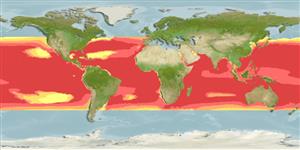Issue
The distinction between Cheilopogon antoncichi and Cheilopogon unicolor awaits clarification.
Environment: milieu / climate zone / profondeur / distribution range
Écologie
marin pelagic-oceanic; océanodrome (Ref. 51243); profondeur 0 - 20 m. Tropical; 46°N - 42°S, 180°E - 180°W
Widespread in tropical zones of all oceans. Western Atlantic: Massachusetts, USA to southern South America (Ref. 7251). Eastern Atlantic: equator eastward to 8°W, Cape Verde. Northwest Atlantic: Canada (Ref. 5951). Indian Ocean: widely distributed but absent from the Red Sea, northern Arabian Sea, and the Persian Gulf (Ref. 3395). Western Pacific: absent in inland waters of southeast Asia (Ref. 9839). Eastern Central Pacific.
Taille / Poids / Âge
Maturité: Lm ? range ? - ? cm
Max length : 35.0 cm TL mâle / non sexé; (Ref. 5217); common length : 25.0 cm TL mâle / non sexé; (Ref. 5217)
Épines dorsales (Total) : 0; Rayons mous dorsaux (Total) : 12 - 14; Épines anales: 0; Rayons mous anaux: 9 - 11. Body dark iridescent blue above, silvery white below; pectorals dark grey, with a broad pale margin crossed by a pale stripe becoming narrower toward anterior fin margin; pelvic fins pale (Ref. 2797). Juveniles up to 10-19 cm SL with dark bars on body and variegated paired fins (Ref. 2797).
Body shape (shape guide): elongated.
Occurs in surface waters of the open ocean (Ref. 30573). Capable of leaping out of the water and gliding for considerable distances above the surface (Ref. 30573). Feeds on zooplankton and small fish (Ref. 9839).
Life cycle and mating behavior
Maturité | Reproduction | Frai | Œufs | Fécondité | Larves
Parin, N.V., 1996. On the species composition of flying fishes (Exocoetidae) in the West-Central part of tropical Pacific. J. Ichthyol. 36(5):357-364. (Ref. 27313)
Statut dans la liste rouge de l'IUCN (Ref. 130435: Version 2025-1)
Menace pour l'homme
Harmless
Utilisations par l'homme
Pêcheries: bycatch
Outils
Articles particuliers
Télécharger en XML
Sources Internet
Estimates based on models
Preferred temperature (Réf.
123201): 20.1 - 28.5, mean 26.2 °C (based on 48395 cells).
Phylogenetic diversity index (Réf.
82804): PD
50 = 0.5000 [Uniqueness, from 0.5 = low to 2.0 = high].
Bayesian length-weight: a=0.00631 (0.00288 - 0.01384), b=3.05 (2.85 - 3.25), in cm total length, based on LWR estimates for this (Sub)family-body shape (Ref.
93245).
Niveau trophique (Réf.
69278): 4.0 ±0.65 se; based on food items.
Résilience (Réf.
120179): Haut, temps minimum de doublement de population inférieur à 15 mois (Preliminary K or Fecundity.).
Fishing Vulnerability (Ref.
59153): Low vulnerability (25 of 100).
🛈
